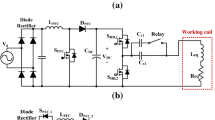Abstract
Induction cooker is an energy-efficient kitchenware and known as the green stove which heats foods by the Joule energy. Coil inductance is an important technical parameter in the induction cooker system which mainly depends on the coil geometry size, the number of coil turns, and the distribution of the iron cores located a short distance away from the coil. Because of the iron cores, the magnetic flux density is nonlinear and the existing analytic formula for calculating coil inductance is not applicable. A three-dimensional finite element model (FEM) is introduced to analyze the distribution of the magnetic flux density and calculate the coil inductance in the induction cooker system in this paper. The FEM computed result is close to the experimental result with the relative error being 0.47%. Furthermore, two correction coefficients are introduced to modify the existing analytic formula and the relative error of the correction formula is less than 3%, which meets the industrial design requirement.
Similar content being viewed by others
References
Monzel, C. and Henneberger, G., Temperature solver for highly nonlinear ferromagnetic materials for thin moving sheets in transversal flux induction heating, IEEE Trans. Magn., 2002, vol. 38, no. 2, pp. 937–940.
Jonghan Kwon, Yoon Jae Nam, Shin, K.H., and Lim, S.H., Efficient cooling method for a cu coil in an induction cooker by using an insulation sheet, J. Magn., 2011, vol. 16, no. 1, pp. 31–35.
Lichan Meng, Ka Wai Eric Cheng, and Ka Wing Chan, Systematic approach to high-power and energy-efficient industrial induction cooker system: circuit design, control strategy, and prototype evaluation, IEEE Trans. Power Electron., 2011, vol. 26, no. 12, pp. 3754–3765.
Meng, L.C., Cheng, K.W.E., Chan, K.W., and Lu, Y., Variable turn pitch coils design for heating performance enhancement of commercial induction cooker, IET Power Electron., 2012, vol. 5, no. 1, pp. 134–141.
Meng, L.C., Cheng, K.W.E., and Ho, S.L., Multicoils design for induction cookers with applying switched exciting method, IEEE Trans. Magn., 2012, vol. 48, no. 11, pp. 4503–4506.
Layth Jameel Buni Qaseer, Micro-T circuit model for double and single sided induction heating systems, Appl. Comput. Electromagn. Soc. (ACES) J., 2010, vol. 25, no. 8, pp. 713–721.
Meng, L.C., Cheng, K.W.E., and Wang, W.M., Thermal impacts of electromagnetic proximity effects in induction cooking system with distributed planar multicoils, IEEE Trans. Magn., 2011, vol. 47, no. 10, pp. 3212–3215.
Boadi, A., Tsuchida, Yu., Takashi Todaka, and Masato Enokizono, Designing of suitable construction of high-frequency induction heating coil by using finite-element method, IEEE Trans. Magn., 2005, vol. 41, no. 10, pp. 4048–4050.
Hiroaki Kurose, Daisuke Miyagi, Norio Takahashi, Naoki Uchida, and Keiji Kawanaka, 3-D eddy current analysis of induction heating apparatus considering heat emission, heat conduction and temperature dependence of magnetic characteristics IEEE Trans. Magn., 2009, vol. 45, no. 3, pp. 1847–1850.
Author information
Authors and Affiliations
Corresponding author
About this article
Cite this article
Qiu, L., Xiao, Y., Wang, S. et al. Design and computation of coil inductance for induction cookers. Russ. Electr. Engin. 86, 106–110 (2015). https://doi.org/10.3103/S1068371215020145
Received:
Published:
Issue Date:
DOI: https://doi.org/10.3103/S1068371215020145




